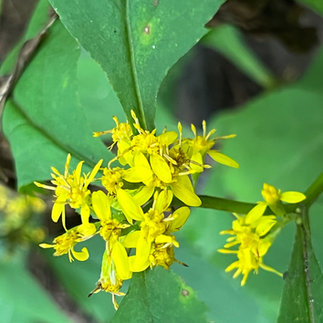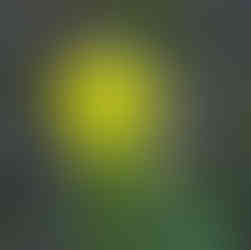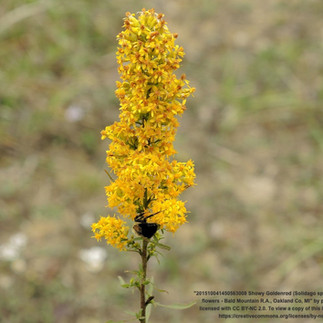Goldenrods, Myths & Misunderstandings
- Michelle
- Feb 16, 2024
- 9 min read
Debunking the Top 3 Goldenrod Myths
I just added two more goldenrods to my webpage, Bog Goldenrod and Tall Goldenrod. I can hear some of you out there asking... "Why??"
The answer is that goldenrods are the single most important plant we sell, and the bad things you may have heard about them just are not true. Plus, they are inherently beautiful. Come along with me while we look a little deeper into goldenrod facts and fallacies:
Goldenrod Myth #1: You already have that.
Soooo many times when I suggest a lovely goldenrod to a client at a market I am rebuffed with "Oh I already have that." Goldenrod is not a single plant, it is a common name for a genus of many different plants. Did you know that there are 23 different species of goldenrod native to Michigan? Goldenrods are so important, it seems nature has crafted one for every habitat. There are goldenrods for fields, like Gray Goldenrod with its graceful curving plumes of gold on frosted stems; goldenrods for beach sand, like Sticky Goldenrod (coming soon); Goldenrods for rocky places, like Hairy Goldenrod; there is ZigZag Goldenrod for forests; Tall Goldenrod for forest edges; Bog Goldenrod for, well, bogs and such; Riddell's Goldenrod for inland lakes and rivers... Almost all of them will do well in your flowerbed, too.
Then there are the flower shapes. Showy Goldenrod, for example, has very long, showy plumes. Early Goldenrod has a dramatic fireworks-type bloom, while ZigZag and Bluestem Goldenrod have a trail of flowers down their stems. Stiff Goldenrod and Grassleaf Goldenrod have flat tops which are the perfect landing zone for pollinators. Those two are also a couple of my favorites - Stiff Goldenrod because it is often shaped like a star when you look at it from the top, and Grassleaf because the flowers are tiny and shiny (Grassleaf is in the genus Euthamia instead of with the rest of the Goldenrods in genus Solidago).
Goldenrods are so entrancing that many have been exported to Europe and Asia the same way the nursery trade here imports things that are "exotic". If the various species of goldenrod are good enough for French flower shops, perhaps we should put a little more value on them ourselves. Of the 23 species native to Michigan, we are doing our part by growing 15 species of goldenrod, with 11 currently up on the website. While you may have a goldenrod or two already in your habitat, I'm pretty sure you don't have all the goldenrods which were meant to be there. Let us help you collect them all!
Goldenrod Myth #2: Goldenrod is Weedy.
We have just established that there are many kinds of goldenrod. "Goldenrod" is not one plant. It follows, therefore, that each goldenrod has its own growth habits for its own particular environmental niche. When people think of goldenrod as weedy, they are usually thinking of Canada Goldenrod.
Canada Goldenrod - a weed with purpose

Canada Goldenrod is a colonizing species. Its job is to move into disturbed areas and take advantage of the empty space - filling it with soil-building roots, shading the earth and creating cover for songbirds and critters, providing fall pollen and nectar resources for pollinators, and filling the world with the butterflies, moths, and other species whose larvae feed on its leaves and stems. That sounds wonderful, doesn't it?
The problem has been that Canada Goldenrod sees pasture, especially overgrazed pasture, as empty space in desperate need of colonization. Even modern landscaping, with its ridiculously short non-native grass and plants isolated from each other in a sea of wood mulch, is barren space ready for the enrichment offered by drifting goldenrod seeds. Once Canada Goldenrod takes hold, it spreads vigorously by both rhizome and seed to make the landscape its own. This makes a lot of people who need edible pasture for their animals, or who want to keep a sterile landscape around their home, a bit cranky. And, since many people do not know about the different kinds of goldenrod, Canada Goldenrod and its colonizing habits becomes the poster child for all goldenrods (or maybe it's a Wanted Dead poster).
Side note: You might notice that we do not currently sell Canada Goldenrod. However, we have the seed and might offer it in the future. Is that a promise or a threat? You be the judge. We have actually gotten a lot of requests for this plant from people looking to out-compete invasive species, or to hold the line against them after a remediation. In our own field, Canada Goldenrod appears to be driving back the invasive Reed Canary Grass that was threatening to bury an entire valley a few years ago. Weediness is in the eye of the beholder - the aggressive nature of Canada Goldenrod is wondrous in the eyes of pollinators, who can find masses and masses of important fall resources wherever Canada Goldenrod is present. It is also wondrous in the eyes of people attempting to rid their fields of non-native spotted knapweed or other invaders. For them, replacing a monoculture of a non-native species which supports little life for a monoculture of one of the most valuable host plants available is an easy trade.
The 22 Species of Not-Canada-Goldenrod
You can be excused, however, if you want a diverse habitat that isn't wall-to-wall Canada Goldenrod, especially if you have a smaller parcel. After all, goldenrod is generally a late bloomer, and while it is essential for the fall landscape, most people would like some flowers throughout the growing season. Not to worry - there is only one Canada Goldenrod, leaving 22 other species of Michigan native goldenrod available for use. Most of the other Goldenrod species are very polite and play well with others in a flowerbed or meadow, adding valuable resources without trying to take over.

In addition to being beautiful spires or explosions of gold in the late-season landscape, all goldenrods are keystone host species - meaning they host essential numbers of moth and butterfly caterpillars. Those caterpillars fuel the ecosystem by feeding birds and other animals, or by producing the massive numbers of pollinators (moths) that are needed to feed everything from birds to bears to bats and other animals, as well as to pollinate and allow the plants to reproduce. Recent studies estimate that 50% of pollination is done by moths, including the pollination of fruit trees and garden crops. Moth caterpillars, like butterfly caterpillars, specialize, meaning each species only eats certain types of plants. Goldenrods feed an astonishing 135 different species of caterpillar. Far more caterpillars specialize on goldenrods than other flowers. As we have seen, there are many goldenrod species, each with a unique bloom time, shape, scent (some of them smell like honey), and relationship to moths, butterflies, and bees. Collect them all, and end the disparagement of this critically important plant.
Some of my favorite goldenrods for gardens are the ones that clump in place and don't wander

about too much. If Canada Goldenrod defines "enthusiastic spreader", Hairy Goldenrod is the poster child for "tidy garden plant", making a lovely clump shooting out from a defined base. Stiff Goldenrod has velvety basal leaves in addition to starry flowers. It may spread a bit under ideal conditions, but in most habitats it stays in a defined bunch. Showy Goldenrod has some of the largest and most dramatic flowers. It spreads slowly by short rhizome into a large mass which is almost like a low shrub of blooms. Bluestem Goldenrod is very polite and clump-forming. ZigZag Goldenrod and Early Goldenrod do some loose spreading, but they are both on the shorter side and are easily contained by surrounding vegetation. Even Tall Goldenrod, which looks suspiciously Canadian but is in fact a different species, is easily kept in check with surrounding vegetation, although it wouldn't be my first choice for a small garden. Don't let the colonizing enthusiasm of Canada Goldenrod shade the reputation of the other 22 Michigan species of goldenrod. Goldenrods are many, and diverse, and are generally not weedy. Use them in your landscape liberally and without fear.
There are no better herbaceous host plants for moths and butterflies. Also consider the birds. Most songbirds feed their young on caterpillars, such as the many which eat goldenrod leaves. The goldenrod you plant this year will supply caterpillars for next year's nestlings. Goldenrods also provide nectar and pollen for future queen bees preparing to overwinter, current queen bees finishing last nest chambers and stocking them with pollen loaves, male bees and wasps looking to complete their life cycle, and butterflies preparing to overwinter or migrate. This much needed buffet of flower resources is a main reason to plant a number of goldenrod species. Early Goldenrod and Bog Goldenrod are some of the earliest bloomers of the family, starting the show in late July or early August. The other species bloom one after another, with Showy Goldenrod finishing the show, persisting into November in some years. If you have only one species of goldenrod in your landscape, you restrict this important fall pollinator resource to a week or so, missing out on months of pollinator support.
Goldenrod Myth #3: Goldenrod makes me sneeze.
And here we are at the big one - the persistent myth that goldenrod causes seasonal allergy symptoms. It is just not true. It is a myth that takes root because of a coincidence of bloom times, is perpetuated by the makers of nasal sprays, and is unwittingly spread by allergists who, let's face it, didn't go to school to study pollen dispersal methods.
Meet Ragweed
Most seasonal allergies are caused by ragweed, a little-noticed green plant which is wind-pollinated and whose sole purpose in life is to fill the late-summer air with pollen. Since it doesn't need to attract bees, ragweed is a boring green, and it simply doesn't command attention when people scan the landscape for the cause of their suffering. But it is there. It is everywhere. Ragweed grows in every ditch, in cracks in city sidewalks, in lawns, empty fields, along the edges of buildings... Yet it goes unnoticed as just another green weed (I use the term weed loosely: ragweed is also a great host plant, despite its annoying pollen). Goldenrod, however, takes the blame for ragweed's crimes just because it is beautiful (noticeable) and happens to bloom at the same time. I will also note that certain nasal spray companies find it easier to vilify goldenrod in their commercials than to educate people on the appearance of ragweed. Don't fall for the marketing ploy. On a hot summer day, when you and I are choking on thick drifts of pollen, it is natural to look around for a visible source to curse. Goldenrod is bright yellow, ragweed is not. However, it is not goldenrod pollen in the air. Let me repeat that: you are not breathing any significant quantities of goldenrod pollen in the fall.

Goldenrod is insect-pollinated. It has evolved elaborate measures to get its pollen to stick to pollinators. Goldenrod does not want its pollen to blow away. Flowering plants such as goldenrod have amazing methods to get their pollen stuck onto just the right kind of insect. These specializations (there's that word again) greatly improve the chances that pollen from one species of plant, Early Goldenrod for example, will make it to another Early Goldenrod individual. The plant does not want to stick its pollen to a bee that will go from Early Goldenrod to Blue Lobelia. That would result in both plants failing to get pollinated. Some flowering plants address this risk by placing their precious pollen into structures that only release for the right shaped bee (wasp, moth, whatever). Most have pollen grains that are microscopically sized and textured to adhere to their specific pollinating insects. Some (many?) even have electrically charged pollen which causes it to stick to oppositely charged bees and moths like a magnet.
(Apologies that my photo for this section is a bumblebee, a generalist pollinator - not the best example of plant/pollinator specialization, but I don't have very many good bee photos.)
The pollen of insect-pollinated plants like goldenrod does not blow around on the wind. It stays on the flower. Plants would not spend energy and resources developing colorful scented flowers to attract insects, custom pollen delivery methods, and pollen designed to stick to their specific insect just to let their pollen drift around on any passing breeze. That breeze serves wind-pollinated plants like ragweed and grasses, whose whole strategy for pollination is to load the air with enough pollen that some will make it to other plants. These plants with little green flowers make so much pollen that they are not bothered a bit if some is sucked up by hapless mammals like you and me. Goldenrod takes the opposite strategy and tries very hard to keep its pollen out of the air.
Yes, the scratch test at your allergist's office for goldenrod may have come back positive, but your allergist is in the business of concocting allergy shots, not studying pollen dispersion methods. Just because you are allergic to goldenrod when someone rubs it into your skin does not mean the pollen is in the air. It might be a good idea in that instance to follow an allergist's advice to avoid eating goldenrod supplements (did I mention goldenrod is a medicinal plant?), but allergists can perhaps be excused for not knowing that goldenrod pollen travels on insects, not in the air. We need to put the blame where it belongs, on the little, green, wind-pollinated plants. Feel free to give ragweed the side-eye while filling your garden with lovely, habitat-rich, does-not-cause-seasonal-allergies goldenrod.
Find Goldenrod at a Plant Sale Near You
You can order your new favorite goldenrods off our website and pick up at our nursery in Marquette in late spring, or you can see what we bring to a plant sale near you. Watch the What's Happening page for details, but here is our summer lineup so far (not including Farmer's Markets, TBD):
June 1, Hancock (Keweenaw Wild Bird REC)
June 8, Marquette (Marquette County Conservation District)
June 8, Chatham (Alger Conservation District)
June 8, Grand Marais (Alger Conservation District)
June 21, Sault Ste Marie (Chippewa Luce Mackinac Conservation District)
July 5, Ironwood (Gogebic Conservation District)
July 6, Watersmeet/Marenisco (Gogebic Conservation District)
August 21, Manistique (Schoolcraft Conservation District)
September 7, Marquette (Marquette County Conservation District)
September 14, Houghton tbd
Love that goldenrod, and as always, thanks for planting native!



























Comments